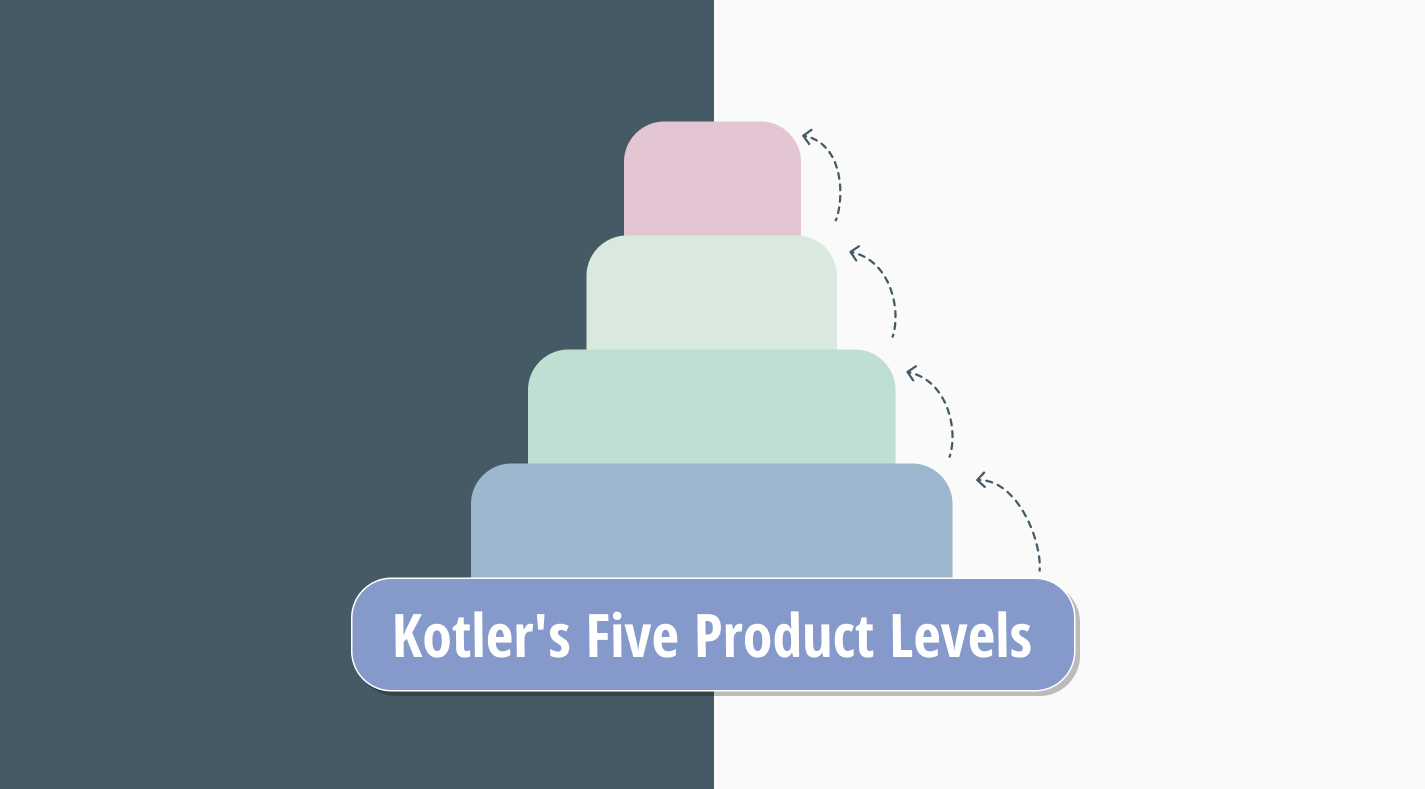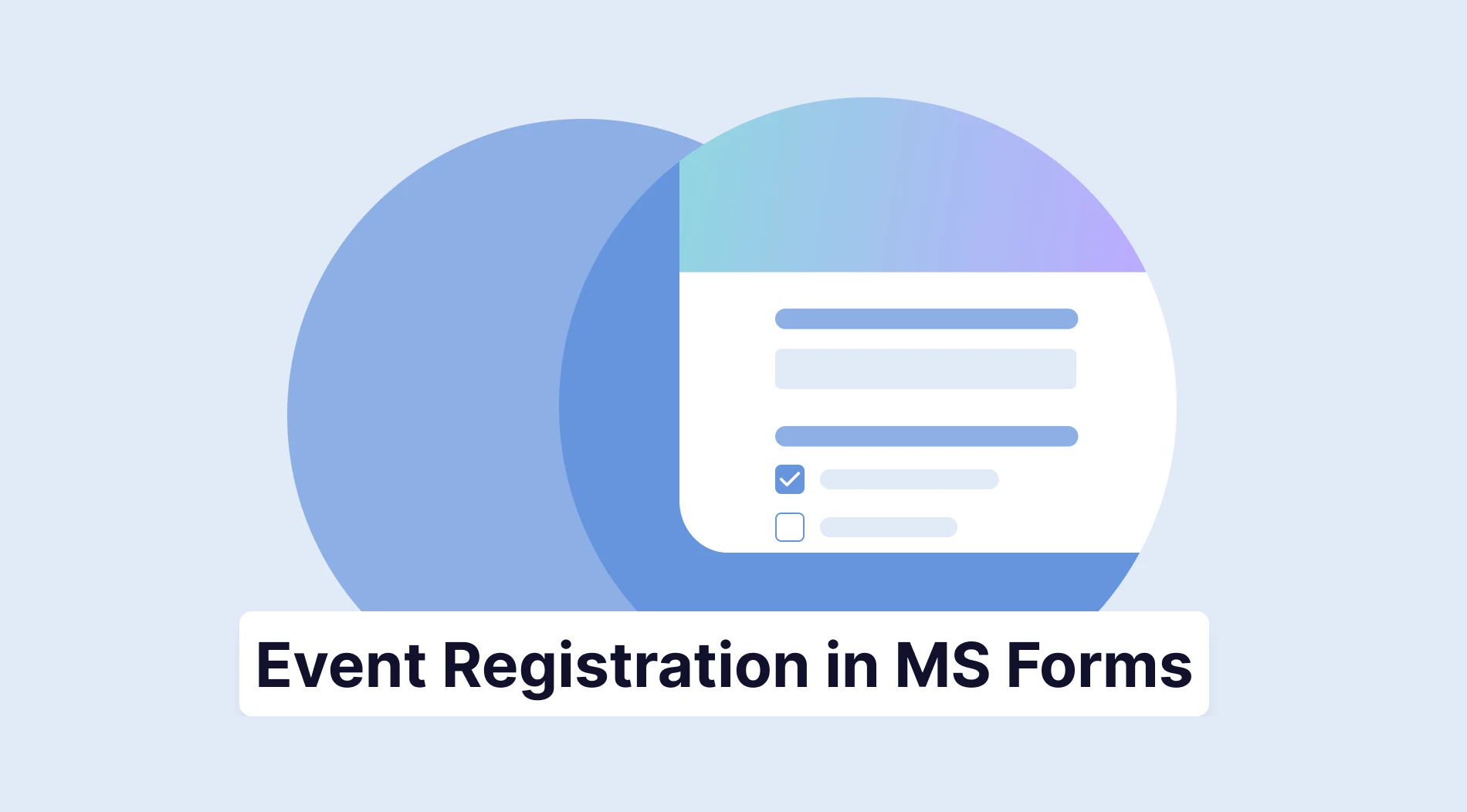Anyone working in sales would know that they need to know what the customers want and need in a product or service. Philip Kotler, an economist, came up with a methodological answer to this question and created the five product levels model, which would benefit both the salespeople and the customers.
The five product levels model differentiates the needs, wants, and demands of a customer. This can help business owners to make their potential products more appealing to a variety of customers. In this article, we show you a clear view of this particular model with examples by explaining the five levels, when the model can be used, and its advantages for creating the best version of your product.
What is Kotler's five product levels model?
Kotler’s five product levels model is a method developed by Philip Kotler to assist salespeople in altering and adapting their products according to their customers’ needs and expectations.
In this way, customers can purchase a product based on their requirements. They can only be satisfied when the product's value aligns with their expectations. This helps both the customer and the salespeople gain core benefits from the augmented product.
When to use Kotler’s five product levels
Kotler’s five product levels model can be used in different situations. This depends on the needs and demands of analyzing the levels of value according to the customer’s expectations.
Here, you can see six examples to illustrate different situations in which the model can be useful:
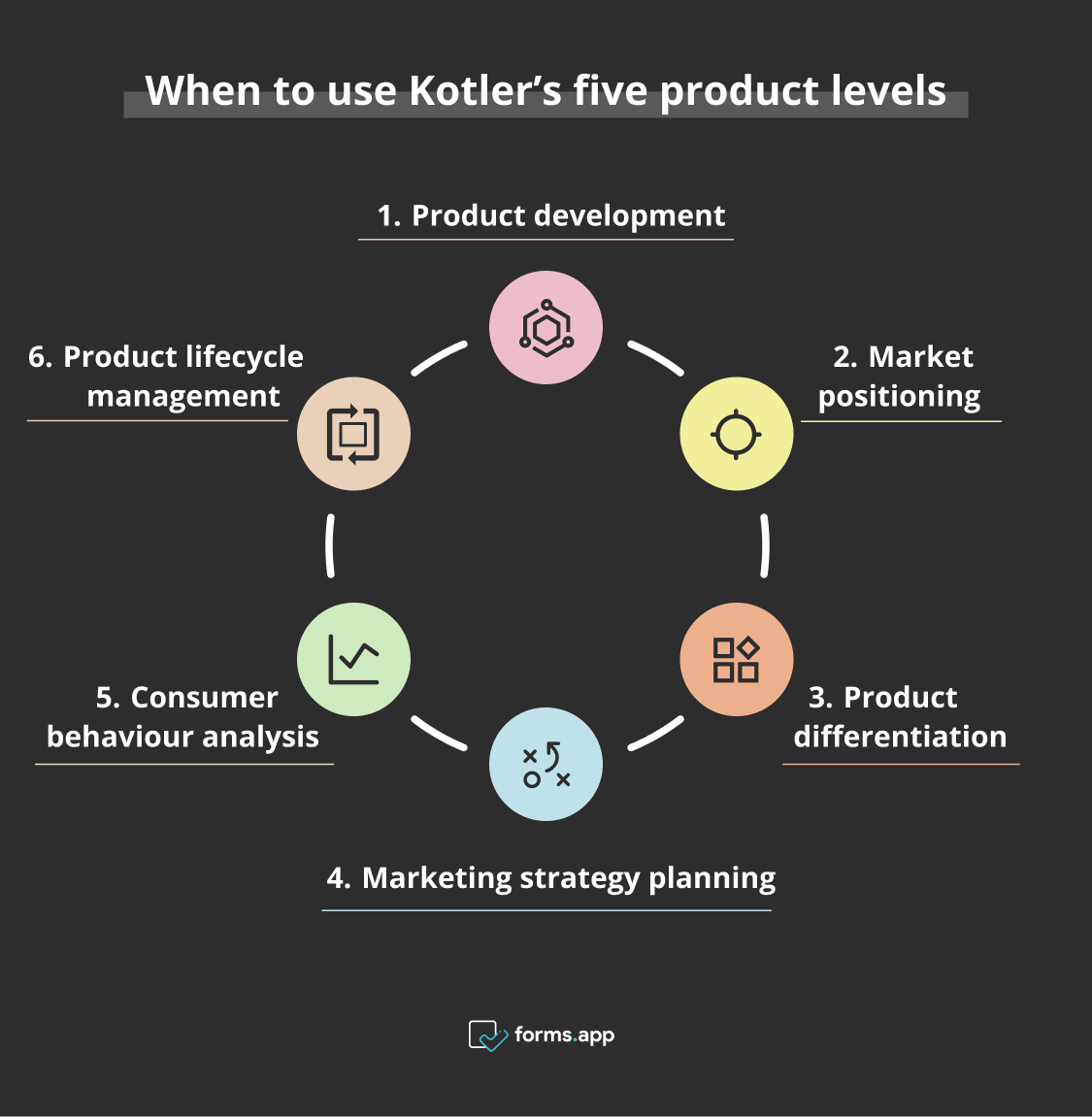
Times to use Kotler’s 5 product levels
1- Product development
During the product development stage, marketers can use the five product levels model to ensure that they are dealing with the customer’s needs. These needs typically include all levels, from the core product features to the augmented level.
2- Market positioning
To create an effective image in the market, marketers can design a distinct image and competitive advantage. Kotler’s five product levels can help marketers understand the levels of the product to position the product effectively and successfully in the market.
3- Product differentiation
There are numerous competitive products in the market, and you want to make sure your product makes a difference. The five product levels can help you identify these areas. From the basic level of the product to the augmented level, you should create individual selling propositions. Increasing the number of higher-level aspects can help achieve this objective.
4- Marketing strategy planning
When planning a marketing strategy, marketers should consider each level of the product. It is important to think about the generic product and the expected product by visualizing the product hierarchy. The five product levels are helpful in planning these marketing efforts to address each of these aspects and to ensure effective communication.
5- Consumer behaviour analysis
Each and every consumer perceives and evaluates a product at different levels. Consumer behavior can help marketers navigate their decision-making process to plan what a product level includes.
This can guide the producers to understand market segmentation, target audience, and positioning strategies. Kotler’s five-product level model is a useful tool for strategically analyzing and planning each level of the product to meet the needs of the consumers.
6- Product lifecycle management
The product lifecycle is not stable, which means that it is likely to change as the consumers need changes during the process. A product includes levels that can undergo many changes in the future compared to the basic version of the product. This process is to exceed customers' expectations at different stages and levels of the product lifecycle to meet changing consumer needs.
Overall, Kotler’s Five Product Levels serves as a helpful and supportive tool to form and transform your products in diverse situations as effectively as possible.
5 product levels with examples
Kotler’s model includes five separate product levels that can help you design and elevate your product according to the customer’s needs and expectations. In this section, we explain the five levels of product with some examples:
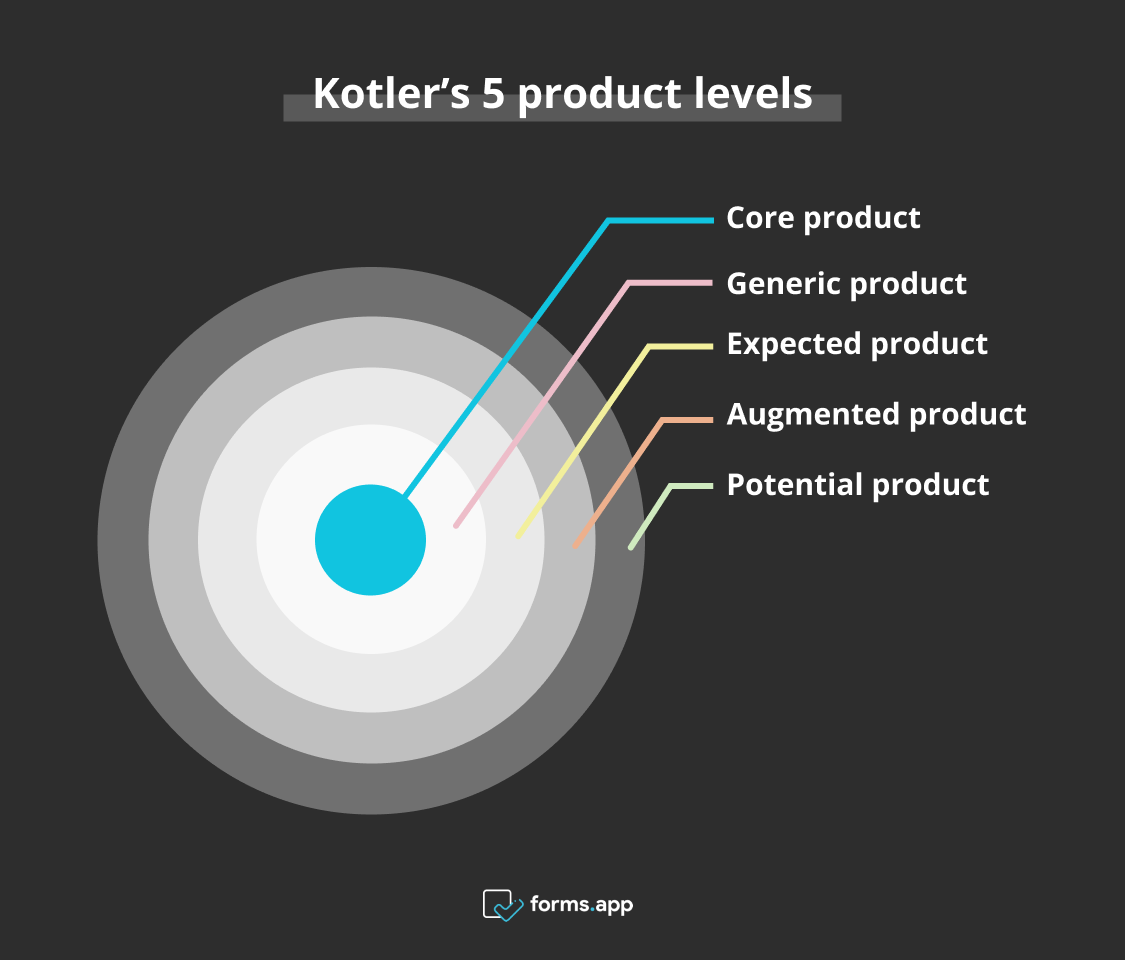
5 product levels of Kotler
1- Core product
The core product level represents the primary needs and benefits a product provides for the customers to satisfy their basic needs. This level of the product deals with the basic problem of bringing out the essential benefit of the product.
Example: A phone that makes calls and sends text messages.
2- Generic product
The generic product level is all about the fundamental features. It presents a product that includes basic and core functions (what the product can do and features at its most basic level) in accordance with the customer’s expectations.
Example: A smartphone that has an internet connection and an app store.
3- Expected product
The expected product includes the features and attributes that customers expect to have as basic requirements when purchasing the product. A customer who has different preferences might expect to see different features from the same product.
Example: A smartphone that is user-friendly, has an appealing design, and a high-quality camera.
4- Augmented product
The augmented product has additional features on top of its basic features that enhance the value of it. The additional benefits and changes also make the product different from its competitors in the market.
Example: A smartphone that has facial recognition and augmented reality features.
5- Potential product
The potential product has any changes or improvements a company might add to the product in the future. This is to increase the value of the product and provide better customer satisfaction by taking into their requirements.
Example: A smartphone that works as a payment device and a health tracker.
All the Kotler’s five levels are developed to support and advance the products according to customers’ needs and preferences. By using Kotler’s model to develop your product or service, you can also meet the expectations of your target audience.
Advantages of using Kotler’s 5 product levels
Now that you know what exactly Kotler’s 5 product levels model is about and when you can use it, it is also practical to know the advantages of this model. Using Kotler’s model helps to increase customer satisfaction, save money, increase sales, and improve customer retention. Below, we explained how these advantages are beneficial:
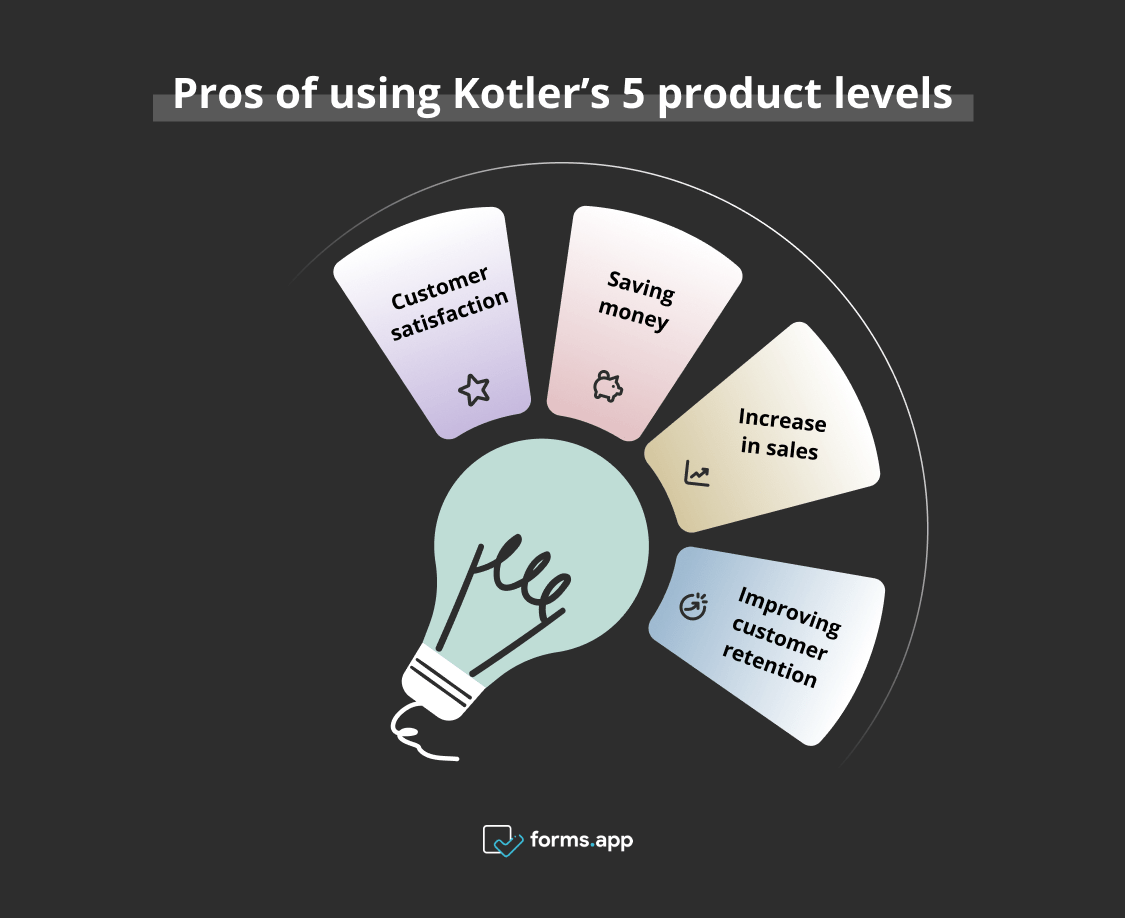
Benefits of Kotler’s 5 product levels
1- Customer satisfaction
As we explained in the previous sections, meeting customer’s needs, requirements, and demands is crucial for a successful business. For instance, if a customer requires a product with generic features, business owners can meet this requirement by using Kotler’s model to assess the need. In this way, customers feel more satisfied, which also increases trust.
2- Saving money
In business, it is always better to keep as much money as you can in your pocket and spend the budget wisely. Using Kotler’s model can help save money on marketing. Businesses can use the model to better understand the customers’ desires and special requirements. This allows them to allocate the money to different areas, for example, to improve their product.
3- Increase in sales
When the product is good for the customers, it is very likely to sell more. By using Kotler’s five product levels model, businesses can adjust their product to customers’ feedback and review. This can give business owners a chance to make their product more appealing and useful to more customers and expand their product.
4- Improving customer retention
Business is not only about making money. It is also strongly about building trust. By meeting customers’ needs and demands, business owners demonstrate a virtue of trust. This also shows that customers feel heard and valued, which encourages loyalty along with sales and growth.
As seen above, all the items are correlated with one another. It will surely become easy to meet all these elements to have a successful product and a good business with the help of Kotler’s model.
Frequently asked questions about five product levels
To clear things up, this section answers the FAQ questions that might help you gain further insight related to Kotler’s product model and theory.
The five steps of Kotler are:
- Understanding the marketplace and consumer needs and wants,
- Designing a customer-driven marketing strategy,
- Constructing an integrated marketing program that delivers superior value,
- Building profitable relationships,
- Creating customer delight and capturing value from customers to create profits and customer equity.
Kotler’s marketing theory has a direct connection to customer satisfaction and profit, which involves creating, communicating, delivering, and exchanging value.
Kotler's 4 Ps are product, price, place, and promotion.
- Product is about the products or services that a company offers to meet the needs of its consumers.
- Price refers to the amount of money that customers are prepared to pay for a product.
- Place is about the right time and location at which a product is made available for the customers.
- Finally, Promotion refers to all the media activities that a company uses to inform, persuade, and influence consumers to buy their products.
Kotler’s 5 A’s customer path is Awareness, Appeal, Ask, Act, and Advocacy:
- Awareness is about the stage where customers become aware of the product through adverts and other forms of promotion.
- Appeal refers to the stage where customers evaluate the product’s relevance to their needs and requirements following the awareness stage.
- Ask about customers looking for more insight about the product to find answers to the questions or concerns they might have.
- Act refers to the stage where customers take action by purchasing the product or being involved in any kind of service a product might offer once they are satisfied with the product features and the information they have gathered.
- Finally, Advocacy refers to the stage where satisfied customers share their opinions and experiences with others through reviews and referrals after using the product.
Final words
Kotler’s five product levels model is a highly beneficial tool for any company with a new product that wants to improve it to make it more appealing and useful to its customers. To make the most of your product and meet your customers’ preferences, you can follow our guidelines as a simple, helpful tool.
In this article, we have explained the five product levels, the advantages of using Kotler’s model, when to use it, and what to expect from it. Kotler’s five product levels model has shown significant attention from business owners and companies aiming to advance their products or services to the next stage.
forms.app, your free form builder
- Unlimited views
- Unlimited questions
- Unlimited notifications
